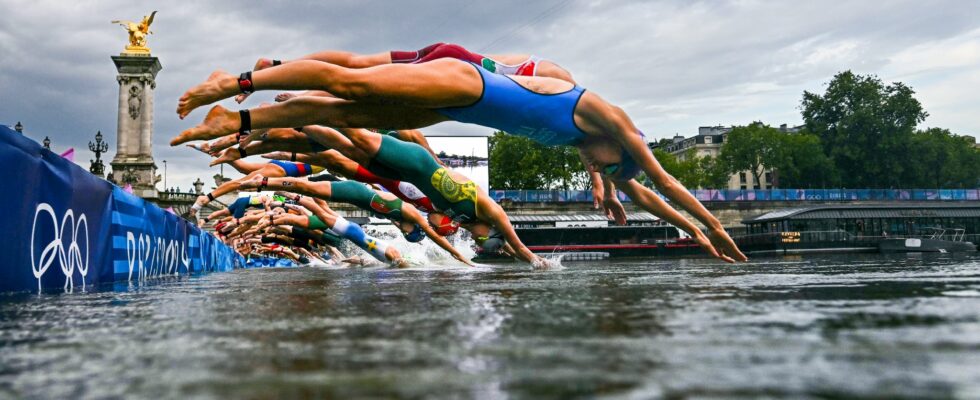For the organizers of the Olympic Games and the mayor of Paris, Anne Hidalgo, the image of athletes diving under the Pont Alexandre III already had the flavor of a victory. After weeks of hesitation, capricious weather and imperfect health surveys, the challenge of a swimmable Seine has been met.
This beautiful image is the culmination of a titanic project. More than three years of work, and 1.4 billion euros of investment, were necessary to reduce the pollution of the river by 75%. The fault lies with the E. coli bacteria and enterococci which proliferated at the time due to the discharge of waste water and the overflowing of sewers during heavy rainfall.
“The Seine is depolluted and will remain clean,” said Anne Hidalgo the day after the closing ceremony. The mayor had promised to make the cleanliness of the river and its swimmability a legacy of the Olympic Games. The work to connect more than 20,000 buildings in the capital and its surroundings to the sewer system, the creation of new treatment plants on the Marne and the construction of a 50,000 cubic meter underground reservoir near the Gare d’Austerlitz should make it possible to achieve this objective, by offering swimming to all from June 2025. Three sites have been identified in the capital: they will be located in Bercy, near the Île Saint-Louis and the Eiffel Tower. Their location was negotiated with users of the river, such as freight carriers and riverboats. They should welcome bathers free of charge in dedicated areas.
Rain, the swimmers’ greatest enemy
But one question remains: will they be able to open throughout the summer? Despite the promise – kept – of the Olympic Games, the reliability of swimming in the river could not be ensured continuously. Of the eleven days scheduled for competitions and training for the triathlon and open water swimming, only five were authorized by the international sports federations. The rest of the time, the river water did not meet the bacteriological standards required by the latter.
“Bathing waters are governed by a European directive, the challenge is to have the Seine classified as a bathing site and for that, it will have to be in good condition regularly,” warns Lionel Cheylus, the spokesperson for the Surfrider Foundation association, which has carried out tests on the Olympic sites. According to this European directive, water is considered bathing water if its quality has not been below the standards for 90% of the last four years.
The work undertaken over the past several years has made it possible to reduce a significant proportion of the river’s contamination during dry weather. Wastewater from old buildings and barges moored on the banks of the Seine no longer flows into it. Nevertheless, the main enemy of swimming in rivers remains rain. Precipitation leads to an increased presence of contaminants, due to pollution from runoff on the ground but also from overflowing sewers. Structures such as the one at Austerlitz were built to contain these discharges, but their capacities are limited. “We will always be subject to rain events and storage or runoff limitation operations are not sufficient to solve the problem during heavy rain. All we can do is increase the threshold of these capacities,” emphasizes Jean-Marie Mouchel, professor of hydrology at Sorbonne University and specialist in the Seine.
Flow rate, the other variable
The second problem comes from the flow of the river. Not only does it make swimming potentially dangerous, it also encourages the presence of pathogenic microorganisms. “When there is a flood, the concentrations of bacteria indicating fecal contamination are high upstream of Paris. And since the flow is high, the water flows very quickly: the bacteria do not have time to degrade,” explains the hydrologist. A phenomenon that the organizers of the triathlon events are well aware of, having experienced it a few days before the scheduled date, forcing them to postpone the start by 24 hours. “We nearly had a disaster. A small flood of the Marne the three days before made the situation really delicate,” recalls Jean-Marie Mouchel. In two days, there had fallen “the equivalent of two weeks of rain in a normal month of July in Paris,” specified the regional prefect Pierre-Antoine Molina at the time.
Despite this strong dependence on weather contingencies, experts are nevertheless optimistic about the future of swimming in Paris. “With the efforts that have been made, we will always have a certain number of suitable days,” assures the hydrologist. Periods as rainy as the one experienced just before the Olympics should remain rare. From then on, the river will display favorable conditions for taking a dip. But only in summer: from mid-September to June, the Seine will not be intended to welcome bathers, warns the Paris city hall. The summer period is preferred because the UV radiation, the low flow of the Seine and less bad weather allow the water quality to be maintained. “The return to normal can happen quickly: between twenty-four and forty-eight hours after a rainy episode, we find bathing thresholds,” assures Lionel Cheylus.
This prospect is not only of interest to residents of the capital. According to the census of the Paris Urban Planning Workshop, more than thirty bathing sites could see the light of day by 2025 on the banks of the Seine and the banks of the Marne. An incentive for municipalities to continue their sanitation efforts. It is also a way for residents of the Paris region to reclaim a river that has long been poorly perceived.
.
